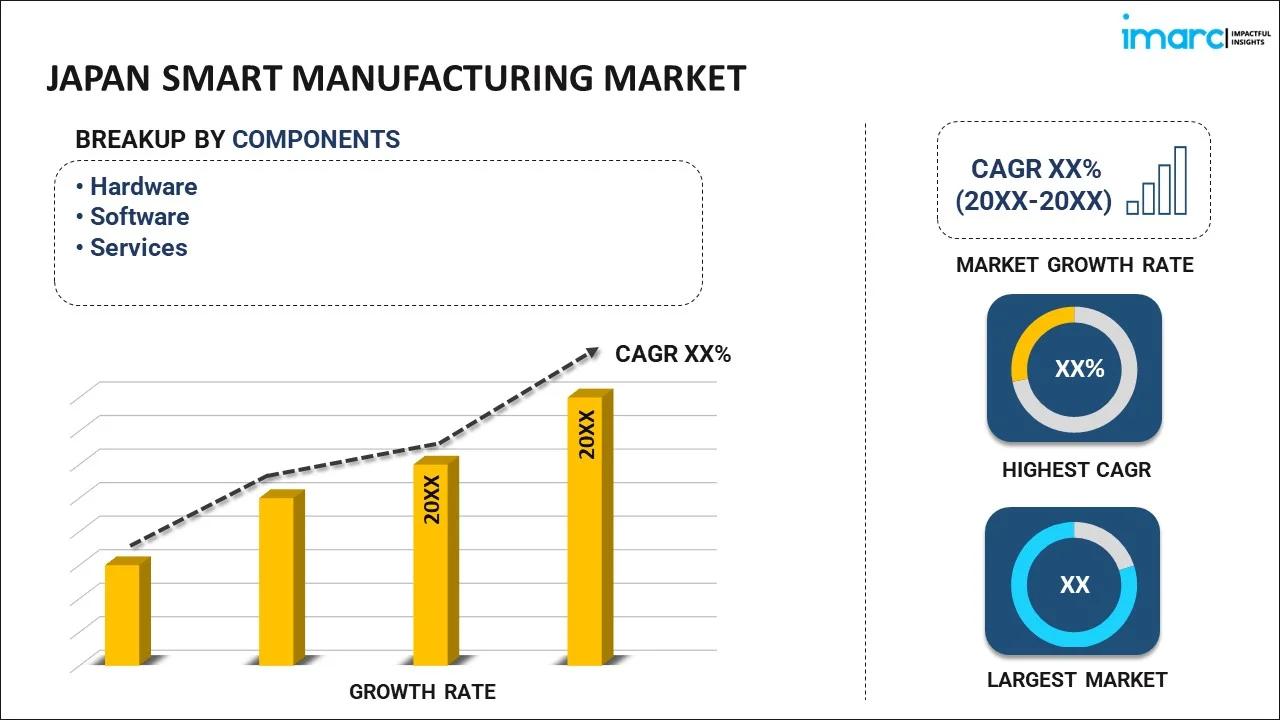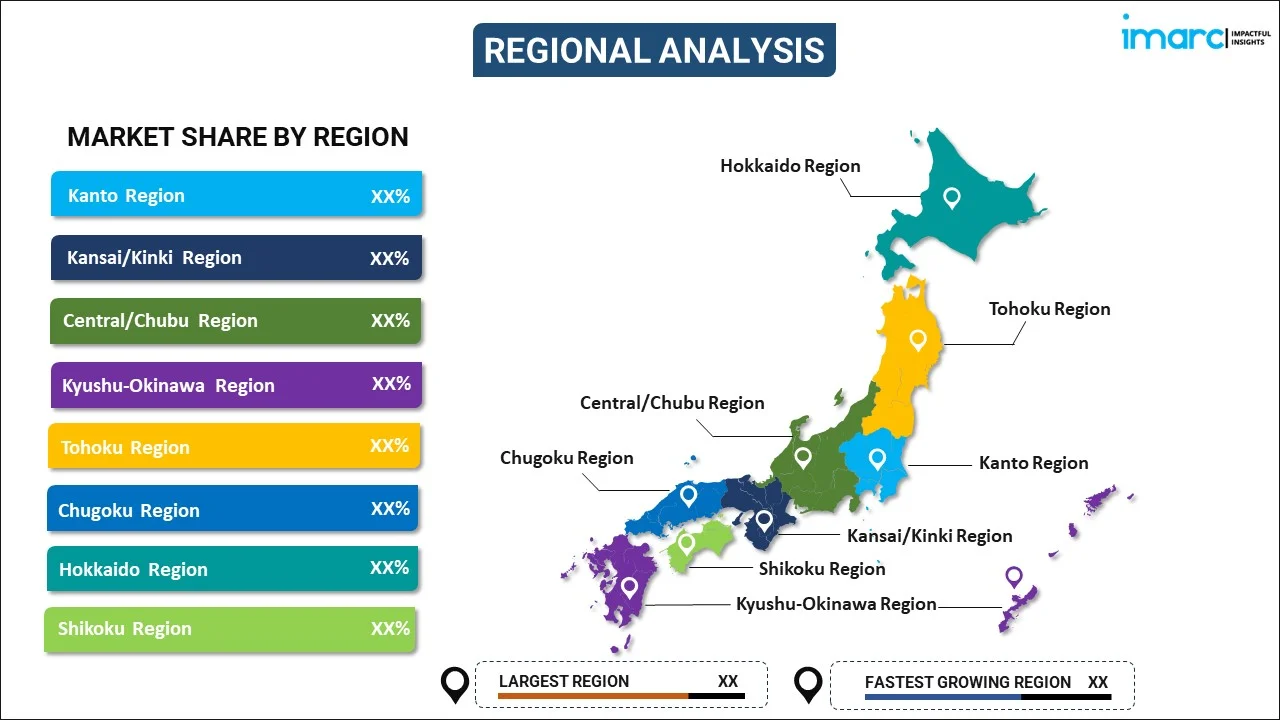
Japan Smart Manufacturing Market Report by Component (Hardware, Software, Services), Technology (Machine Execution Systems, Programmable Logic Controller, Enterprise Resource Planning, SCADA, Discrete Control Systems, Human Machine Interface, Machine Vision, 3D Printing, Product Lifecycle Management, Plant Asset Management), End Use (Automotive, Aerospace and Defense, Chemicals and Materials, Healthcare, Industrial Equipment, Electronics, Food and Agriculture, Oil and Gas, and Others), and Region 2025-2033
Market Overview:
Japan smart manufacturing market size reached USD 22.8 Billion in 2024. Looking forward, IMARC Group expects the market to reach USD 120.1 Billion by 2033, exhibiting a growth rate (CAGR) of 18.1% during 2025-2033. The increasing demand for smart manufacturing technologies, such as automation, robotics, and data analytics, that help companies reduce operational costs and improve overall efficiency in production processes, is primarily driving the market.
|
Report Attribute
|
Key Statistics
|
|---|---|
|
Base Year
|
2024 |
|
Forecast Years
|
2025-2033 |
|
Historical Years
|
2019-2024
|
| Market Size in 2024 | USD 22.8 Billion |
| Market Forecast in 2033 | USD 120.1 Billion |
| Market Growth Rate (2025-2033) | 18.1% |
Smart manufacturing, also known as Industry 4.0 or the fourth industrial revolution, is a transformative approach to production that leverages advanced technologies to optimize manufacturing processes. It integrates digital tools, such as the Internet of Things (IoT), artificial intelligence (AI), data analytics, and automation, to enhance efficiency, flexibility, and productivity in factories. Key components of smart manufacturing include real-time data collection from sensors on machines and products, which enables predictive maintenance and quality control. AI algorithms analyze this data to optimize production schedules, minimize downtime, and reduce waste. Automation, including robotics and autonomous systems, streamlines repetitive tasks and improves precision. Furthermore, smart manufacturing promotes connectivity across the entire supply chain, facilitating seamless communication between suppliers, manufacturers, and customers. This interconnectedness fosters agile and responsive production, allowing companies to adapt quickly to market demands. In essence, smart manufacturing empowers industries to become more efficient, sustainable, and competitive by harnessing the power of digital technologies to revolutionize how goods are produced, monitored, and delivered.
Japan Smart Manufacturing Market Trends:
The smart manufacturing market in Japan is poised for remarkable growth in the coming years, driven by a confluence of factors. Firstly, the relentless advancement in technology, coupled with the proliferation of the IoT, has provided a robust foundation for the integration of smart manufacturing solutions. Moreover, the escalating demand for increased efficiency and cost-effectiveness in manufacturing processes serves as a pivotal driver. Furthermore, the ever-increasing complexity of modern production lines necessitates intelligent automation and data-driven decision-making, fostering the adoption of smart manufacturing. Additionally, stringent regulatory requirements, especially in sectors such as pharmaceuticals and food production, have compelled manufacturers to embrace smart manufacturing practices to ensure compliance and quality control. The imperative need for sustainability and reduced environmental impact in manufacturing operations has also accelerated the growth of this market. Lastly, the potential for increased competitiveness and profitability, arising from streamlined operations and improved product quality, which continues to entice companies to invest in smart manufacturing technologies, is expected to drive the market in Japan during the forecast period.
Japan Smart Manufacturing Market Segmentation:
IMARC Group provides an analysis of the key trends in each segment of the market, along with forecasts at the country level for 2025-2033. Our report has categorized the market based on component, technology, and end use.
Component Insights:

- Hardware
- Software
- Services
The report has provided a detailed breakup and analysis of the market based on the component. This includes hardware, software, and services.
Technology Insights:
- Machine Execution Systems
- Programmable Logic Controller
- Enterprise Resource Planning
- SCADA
- Discrete Control Systems
- Human Machine Interface
- Machine Vision
- 3D Printing
- Product Lifecycle Management
- Plant Asset Management
A detailed breakup and analysis of the market based on the technology have also been provided in the report. This includes machine execution systems, programmable logic controller, enterprise resource planning, SCADA, discrete control systems, human machine interface, machine vision, 3D printing, product lifecycle management, and plant asset management.
End Use Insights:
- Automotive
- Aerospace and Defense
- Chemicals and Materials
- Healthcare
- Industrial Equipment
- Electronics
- Food and Agriculture
- Oil and Gas
- Others
The report has provided a detailed breakup and analysis of the market based on the end use. This includes automotive, aerospace and defense, chemicals and materials, healthcare, industrial equipment, electronics, food and agriculture, oil and gas, and others.
Regional Insights:

- Kanto Region
- Kansai/Kinki Region
- Central/ Chubu Region
- Kyushu-Okinawa Region
- Tohoku Region
- Chugoku Region
- Hokkaido Region
- Shikoku Region
The report has also provided a comprehensive analysis of all the major regional markets, which include Kanto Region, Kansai/Kinki Region, Central/ Chubu Region, Kyushu-Okinawa Region, Tohoku Region, Chugoku Region, Hokkaido Region, and Shikoku Region.
Competitive Landscape:
The market research report has also provided a comprehensive analysis of the competitive landscape. Competitive analysis such as market structure, key player positioning, top winning strategies, competitive dashboard, and company evaluation quadrant has been covered in the report. Also, detailed profiles of all major companies have been provided.
Japan Smart Manufacturing Market Report Coverage:
| Report Features | Details |
|---|---|
| Base Year of the Analysis | 2024 |
| Historical Period | 2019-2024 |
| Forecast Period | 2025-2033 |
| Units | Billion USD |
| Scope of the Report | Exploration of Historical Trends and Market Outlook, Industry Catalysts and Challenges, Segment-Wise Historical and Future Market Assessment:
|
| Components Covered | Hardware, Software, Services |
| Technologies Covered | Machine Execution Systems, Programmable Logic Controller, Enterprise Resource Planning, SCADA, Discrete Control Systems, Human Machine Interface, Machine Vision, 3D Printing, Product Lifecycle Management, Plant Asset Management |
| End Uses Covered | Automotive, Aerospace and Defense, Chemicals and Materials, Healthcare, Industrial Equipment, Electronics, Food and Agriculture, Oil and Gas, Others |
| Regions Covered | Kanto Region, Kansai/Kinki Region, Central/ Chubu Region, Kyushu-Okinawa Region, Tohoku Region, Chugoku Region, Hokkaido Region, Shikoku Region |
| Customization Scope | 10% Free Customization |
| Post-Sale Analyst Support | 10-12 Weeks |
| Delivery Format | PDF and Excel through Email (We can also provide the editable version of the report in PPT/Word format on special request) |
Key Questions Answered in This Report:
- How has the Japan smart manufacturing market performed so far and how will it perform in the coming years?
- What has been the impact of COVID-19 on the Japan smart manufacturing market?
- What is the breakup of the Japan smart manufacturing market on the basis of component?
- What is the breakup of the Japan smart manufacturing market on the basis of technology?
- What is the breakup of the Japan smart manufacturing market on the basis of end use?
- What are the various stages in the value chain of the Japan smart manufacturing market?
- What are the key driving factors and challenges in the Japan smart manufacturing?
- What is the structure of the Japan smart manufacturing market and who are the key players?
- What is the degree of competition in the Japan smart manufacturing market?
Key Benefits for Stakeholders:
- IMARC’s industry report offers a comprehensive quantitative analysis of various market segments, historical and current market trends, market forecasts, and dynamics of the Japan smart manufacturing market from 2019-2033.
- The research report provides the latest information on the market drivers, challenges, and opportunities in the Japan smart manufacturing market.
- Porter's five forces analysis assist stakeholders in assessing the impact of new entrants, competitive rivalry, supplier power, buyer power, and the threat of substitution. It helps stakeholders to analyze the level of competition within the Japan smart manufacturing industry and its attractiveness.
- Competitive landscape allows stakeholders to understand their competitive environment and provides an insight into the current positions of key players in the market.
Need more help?
- Speak to our experienced analysts for insights on the current market scenarios.
- Include additional segments and countries to customize the report as per your requirement.
- Gain an unparalleled competitive advantage in your domain by understanding how to utilize the report and positively impacting your operations and revenue.
- For further assistance, please connect with our analysts.
 Inquire Before Buying
Inquire Before Buying
 Speak to an Analyst
Speak to an Analyst
 Request Brochure
Request Brochure
 Request Customization
Request Customization




.webp)




.webp)












